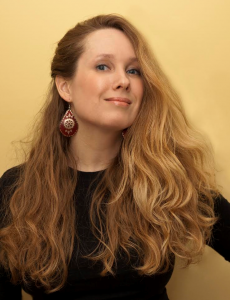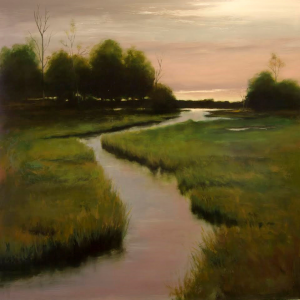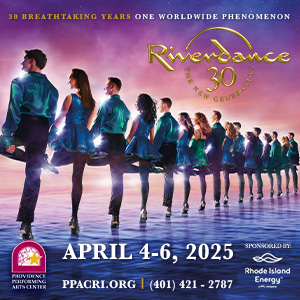 Karen Murphy created her first painting at 13 and hasn’t stopped. When I asked her where it was, she thought it might be in one of her parents’ closets somewhere, but Karen’s work should be out of the closets and everywhere! Her Tonalist style and her unique water and seascapes are one-of-a-kind. Her paintings will have you pondering, ‘”How do I fit in?” and “Where am I about to go?” They’re genuinely poetic.
Karen Murphy created her first painting at 13 and hasn’t stopped. When I asked her where it was, she thought it might be in one of her parents’ closets somewhere, but Karen’s work should be out of the closets and everywhere! Her Tonalist style and her unique water and seascapes are one-of-a-kind. Her paintings will have you pondering, ‘”How do I fit in?” and “Where am I about to go?” They’re genuinely poetic.
Karen and I spoke in her Riverside studio where she lives with her husband and two friendly pooches.
Carrie Decker (Motif): Your work is very fluid and serene. How would you describe the water that is featured in a lot of your pieces?
Karen Murphy: Water is about life and vitality, that’s the biggest reason. Everything needs water to live and for balance; it’s very important and can mean so many things. I do include it in many of my paintings for stability and compositional reasons. Sometimes I could add a path, but I like to add water. I love being in the marshes when I plein air paint because they are so quiet and peaceful and they have so much life.
CD: Do you continue to paint outdoors (plein air) frequently?
 KM: I have always as a kid gone outdoors to find spiritual rejuvenation. It’s where I go to find peace and it’s an important part of my studio process. I don’t paint from photos. I have my studies along with my memories and getting out there and doing it. I don’t do it in the winter months as my hands get cold! I’ve done a few winter paintings, but I don’t paint in the cold. I’m a warm weather girl.
KM: I have always as a kid gone outdoors to find spiritual rejuvenation. It’s where I go to find peace and it’s an important part of my studio process. I don’t paint from photos. I have my studies along with my memories and getting out there and doing it. I don’t do it in the winter months as my hands get cold! I’ve done a few winter paintings, but I don’t paint in the cold. I’m a warm weather girl.
CD: You have been influenced by American male painters (particularly the Hudson River school). Have you been to the Hudson Valley?
KM: No I have not been there, but am planning on going there to paint one day! I am Influenced by the Tonalist movement of the 19th century. American Tonalist more than the Barbizon school. The Tonalists were from the late 1800s to 1920ish when it most popular. American artists were coming back from Europe from the Barbizon school and were learning new techniques. Hudson River school was doing more elaborate detailed landscape painting and there was a need for a softer painting style. The Tonalists were not as detailed, but more poetic; there was no effort to communicate a story or method, but instead to arrange or create a visual poem. It was not an exact replica, like the Hudson River school, they painted more generalized areas, by not using references. They made everything up and were more subdued with soft dominant tones. Some used light palletes and some used dark palletes. It was essentially found light and more about the style. To get the look, Tonalists started with dark pigments with no use of black. I use that mixture to get a compositional map down and play with the colors and it evolves from there. At times I am 80% – 90% there and set them aside so I don’t overwork it. There is a fine line between finished and overworking it. If I get stuck, the work goes into storage and then I go back with fresh eyes. You can discover and have a revelation at any point. It’s really great!
CD: You paint in lively and vivid colors with your smaller works; do you feel they are more energetic?
KM: Before I left my job to paint full time I was a daily painter, I always had a studio and struggled to paint every day. I didn’t always have time to do shows and sometimes months would go by without me painting. I need to paint every day and felt the need to make time for it, so I started a daily painting movement. A small painting for each day. To me it was a fun way to make time to paint. I started giving them as gifts to people. It was not my normal work and I used the 3 primaries and white paint. I have tried to keep it going as it’s fun with light and distraction from my other work. Nowadays, I keep painting the shells (oysters and quahogs) because they are so popular and I get to eat the Matunuck oysters. I have piles of them everywhere and everyone loves them. This year I am doing a series of them on raw linen. (Writer’s note: They are fabulous!!) I place them on the floor and paint them. I wish I could do more of them because they’re fun. They keep my skillsets sharp.
CD: What do you see is a movement artists are using today in the 21st century versus 20 years ago?
KM: I think the biggest change is technology and that has changed the way artists create. When I started painting they didn’t have that. I see a lot more installation art, video work, performance art, and also political work. When I started painting, artists were focused on creating their own style and unique body of work and now people are using technology to make a statement. I really am drawn to the traditional techniques that the masters have used. I study as much as I can. I like to stay traditional — that’s just me.
CD: What is the most daring thing you have painted to date and why?
KM: I don’t think I am a very daring painter. I think every painting is daring as I put my heart and soul into everything I paint. I am opening up and exposing myself. Maybe my lighthouse painting that I painted and sketched from my kayak! That was daring.
Karen’s work is can be viewed and purchased on her web site; KarenMurphyFineArt.com

